Average Power Handling Capability of Corrugated Slow-Wave Transmission Lines
Abstract
:1. Introduction
2. Analysis of the Corrugated Slow-Wave Transmission Lines
2.1. Dispersion Characteristics
2.2. Extraction of Conductor and Dielectric Attenuation
3. Modeling of Thermal Resistance
3.1. Thermal Resistance for U-Shaped Corrugated SWTL
3.2. Thermal Resistance for H-Shaped Corrugated SWTL
4. Derivation of Average Power Handling Capability
5. Numerical Results and Discussion
5.1. Temperature Rise of U-Shaped Corrugated SWTL
5.2. Temperature Rise of H-Shaped Corrugated SWTL
5.3. APHCs of the Corrugated SWTLs
6. Conclusions
Author Contributions
Funding
Conflicts of Interest
References
- Lu, J.; Zhang, H.C.; He, P.H.; Zhang, L.P.; Cui, T.J. Design of Miniaturized Antenna Using Corrugated Microstrip. IEEE Trans. Antennas Propag. 2020, 68, 1918–1924. [Google Scholar] [CrossRef]
- Wang, M.; Tang, M.; Zhang, L.P.; Zhang, H.C.; Xu, J.; Cui, T.J.; Mao, J. Miniaturization of Frequency-Reconfigurable Antenna Using Periodic Slow-Wave Structure. IEEE Trans. Antennas Propag. 2021, 69, 7889–7894. [Google Scholar] [CrossRef]
- Zhao, B.; Tang, M.; Shao, Z.; Zhang, Y.; Mao, J. Design of Broadband Compact Grid Array Antennas Using Gradient Slow-Wave Structures. IEEE Antennas Wirel. Propag. Lett. 2022, 21, 620–624. [Google Scholar] [CrossRef]
- Rawat, K.; Ghannouchi, F.M. A Design Methodology for Miniaturized Power Dividers Using Periodically Loaded Slow Wave Structure with Dual-Band Applications. IEEE Trans. Microw. Theory Tech. 2009, 57, 3380–3388. [Google Scholar] [CrossRef]
- Li, M.; Zhang, Z.; Tang, M.-C.; Yi, D.; Ziolkowski, R.W. Compact Series-Fed Microstrip Patch Arrays Excited with Dolph–Chebyshev Distributions Realized with Slow Wave Transmission Line Feed Networks. IEEE Trans. Antennas Propag. 2020, 68, 7905–7915. [Google Scholar] [CrossRef]
- Zhang, L.P.; Zhang, H.C.; Tang, W.; Shao, C.; He, P.H.; Tang, M.; Mao, J.-F.; Cui, T.J. A Broadband 90° Balun with Low-Phase-Imbalance Performance Based on Periodic Slow Wave Structure. IEEE Trans. Antennas Propag. 2021, 69, 4681–4687. [Google Scholar] [CrossRef]
- Bahl, I.J.; Gupta, K.C. Average Power-Handling Capability of Microstrip Lines. IEE J. Microw. Opt. Acoust. 1979, 3, 1–4. [Google Scholar] [CrossRef]
- Bahl, I.J. Average Power Handling Capability of Multilayer Microstrip Lines. Int. J. RF Microw. Comput.-Aided Eng. 2001, 11, 385–395. [Google Scholar] [CrossRef]
- Sanchez-Soriano, M.A.; Quere, Y.; Le Saux, V.; Quendo, C.; Cadiou, S. Average Power Handling Capability of Microstrip Passive Circuits Considering Metal Housing and Environment Conditions. IEEE Trans. Compon. Packag. Manuf. Technol. 2014, 4, 1624–1633. [Google Scholar] [CrossRef] [Green Version]
- Sanchez-Soriano, M.A.; Quere, Y.; Le Saux, V.; Marini, S.; Reglero, M.S.; Boria, V.E.; Quendo, C. Peak and Average Power Handling Capability of Microstrip Filters. IEEE Trans. Microw. Theory Tech. 2019, 67, 3436–3448. [Google Scholar] [CrossRef] [Green Version]
- Wu, L.-S.; Zhou, X.-L.; Yin, W.-Y.; Tang, M.; Zhou, L. Characterization of Average Power Handling Capability of Bandpass Filters Using Planar Half-Wavelength Microstrip Resonators. IEEE Microw. Wirel. Compon. Lett. 2009, 19, 686–688. [Google Scholar]
- Yin, W.-Y.; Dong, X.; Gan, Y.B. Frequency-Dependent Maximum Average Power-Handling Capabilities of Single and Edge-Coupled Microstrip Lines on Low-Temperature Co-Fired Ceramic (LTCC) Substrates. Int. J. RF Microw. Comput.-Aided Eng. 2006, 16, 103–117. [Google Scholar] [CrossRef]
- Yin, W.-Y.; Kang, K.; Mao, J.-F. Electromagnetic-Thermal Characterization of on On-Chip Coupled (A)Symmetrical Interconnects. IEEE Trans. Adv. Packag. 2007, 30, 851–863. [Google Scholar] [CrossRef]
- Yin, W.-Y.; Zhang, Y.; Dong, X.; Gan, Y.B. Average Power-Handling Capability of the Signal Line in Coplanar Waveguides on Polyimide and GaAs Substrates Including the Irregular Line Edge Shape Effects. Int. J. RF Microw. Comput.-Aided Eng. 2005, 15, 156–163. [Google Scholar] [CrossRef]
- Tai, T.-C.; Wu, H.-W.; Wang, Y.-H.; Chiu, C.-T. Microwave Characteristics of Thin-Film Passivation on Ceramic Substrate by Using DC Reactive Magnetron Sputtering. IEEE Trans. Compon. Packag. Manuf. Technol. 2018, 8, 1800–1806. [Google Scholar] [CrossRef]
- Marks, R.B. A Multiline Method of Network Analyzer Calibration. IEEE Trans. Microw. Theory Tech. 1991, 39, 1205–1215. [Google Scholar] [CrossRef] [Green Version]
- Holway, L.H.; Adlerstein, M.G. Approximate Formulas for the Thermal Resistance of IMPATT Diodes Compared with Computer Calculations. IEEE Trans. Electron Devices 1977, 24, 156–159. [Google Scholar] [CrossRef]
- Masana, F.N. A Closed Form Solution of Junction to Substrate Thermal Resistance in Semiconductor Chips. IEEE Trans. Compon. Packag. Manuf. Technol. Part A 1996, 19, 539–545. [Google Scholar] [CrossRef]
- Holman, J.P. Heat Transfer, 10th ed.; McGraw-Hill: New York, NY, USA, 2010. [Google Scholar]
- Pozar, D.M. Microwave Engineering, 4th ed.; Wiley: Hoboken, NJ, USA, 2012. [Google Scholar]





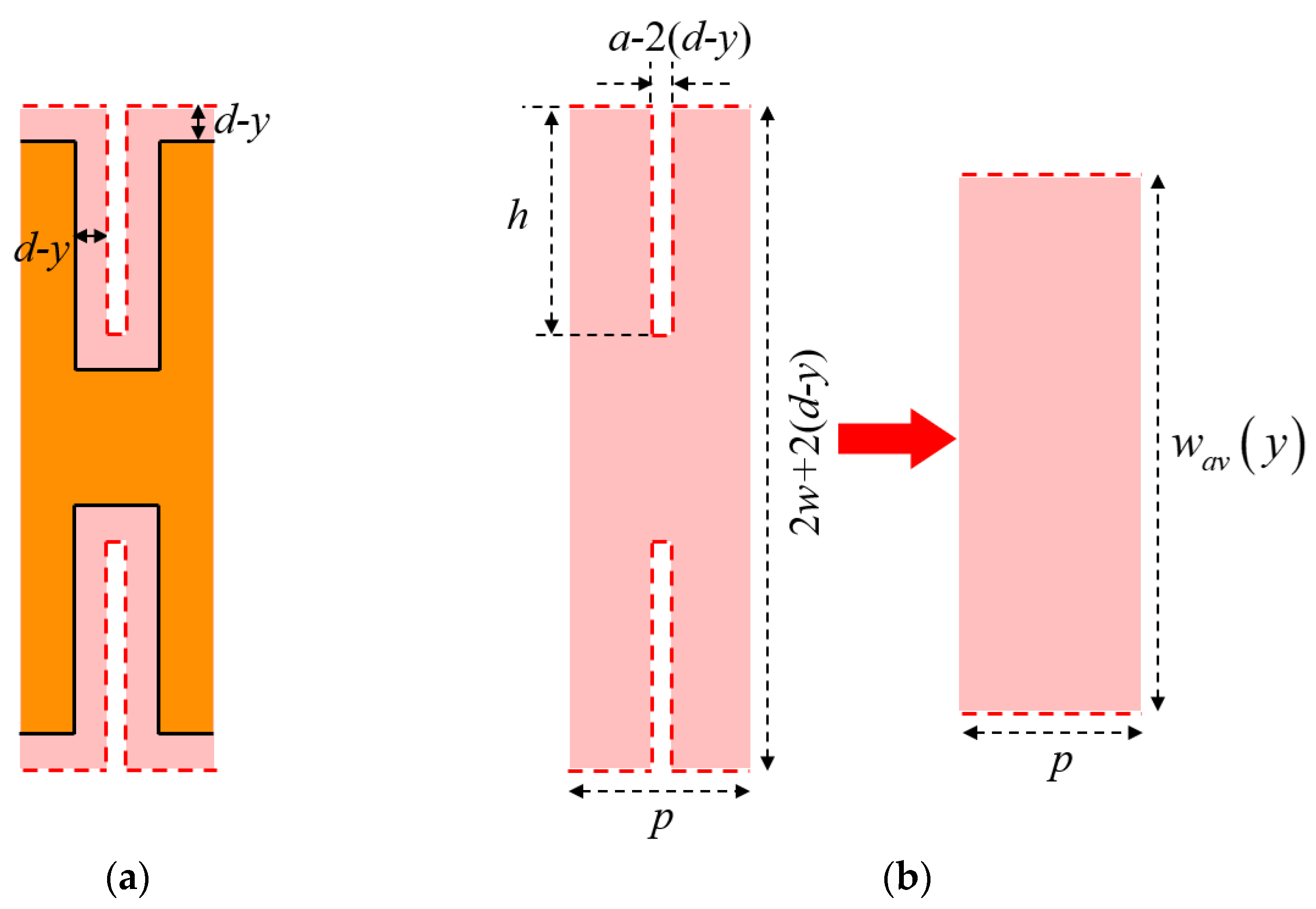
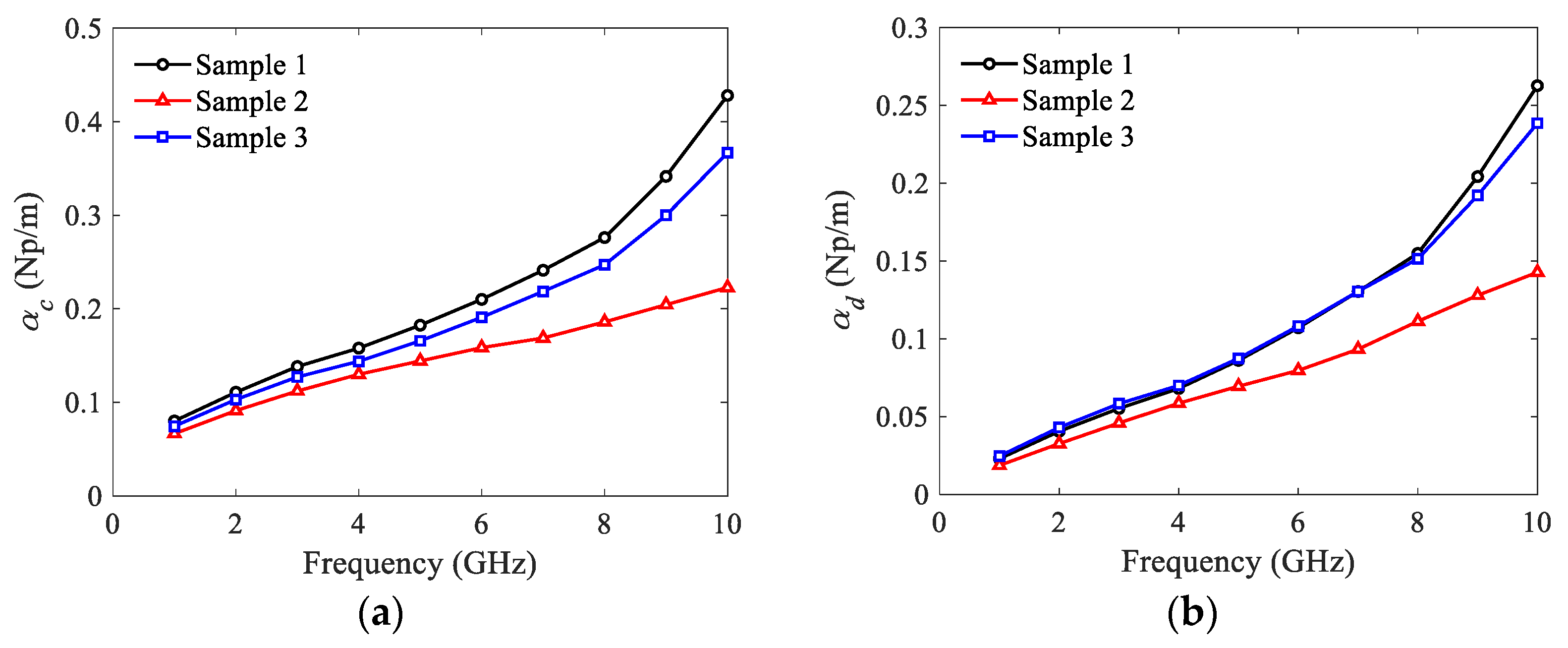
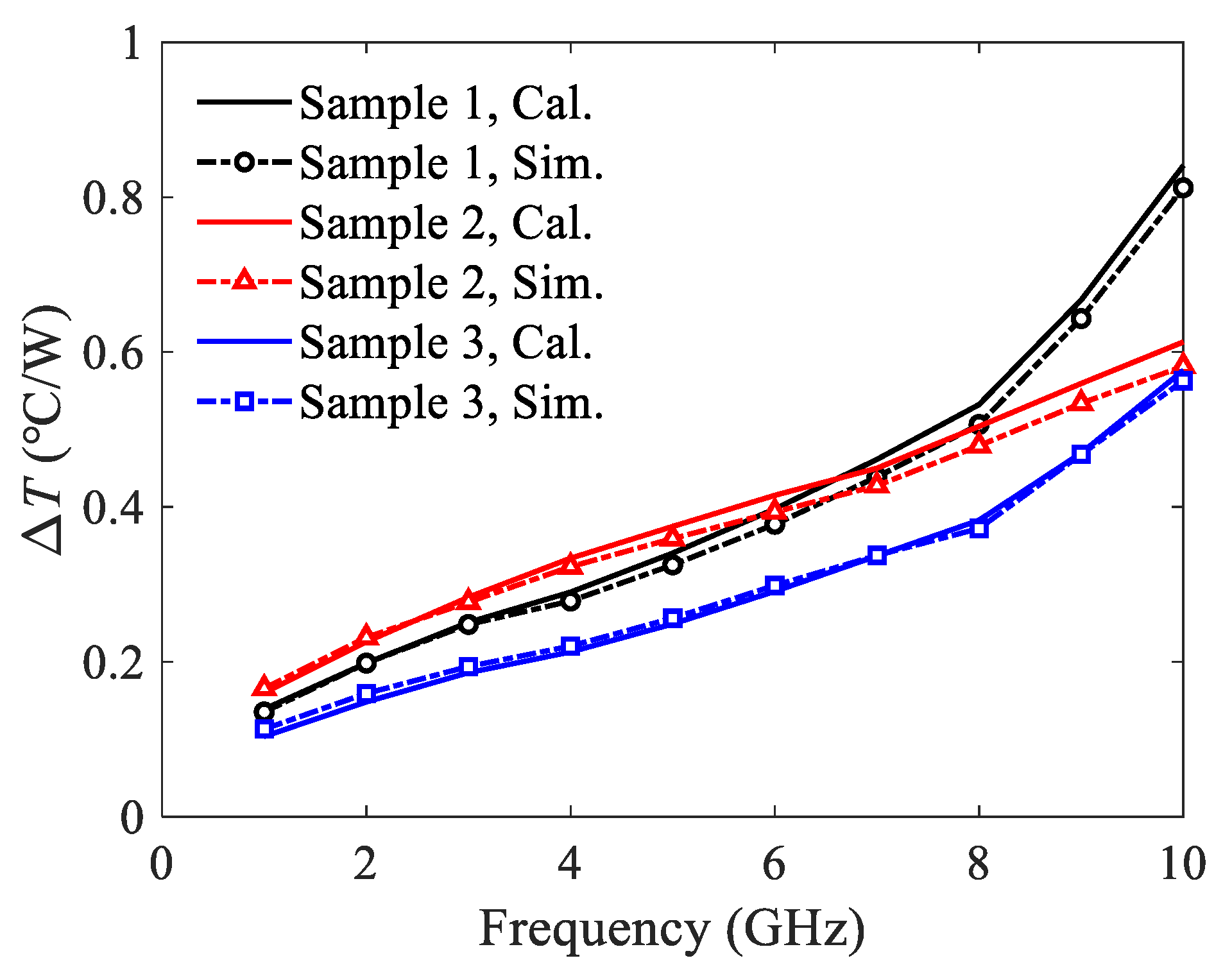


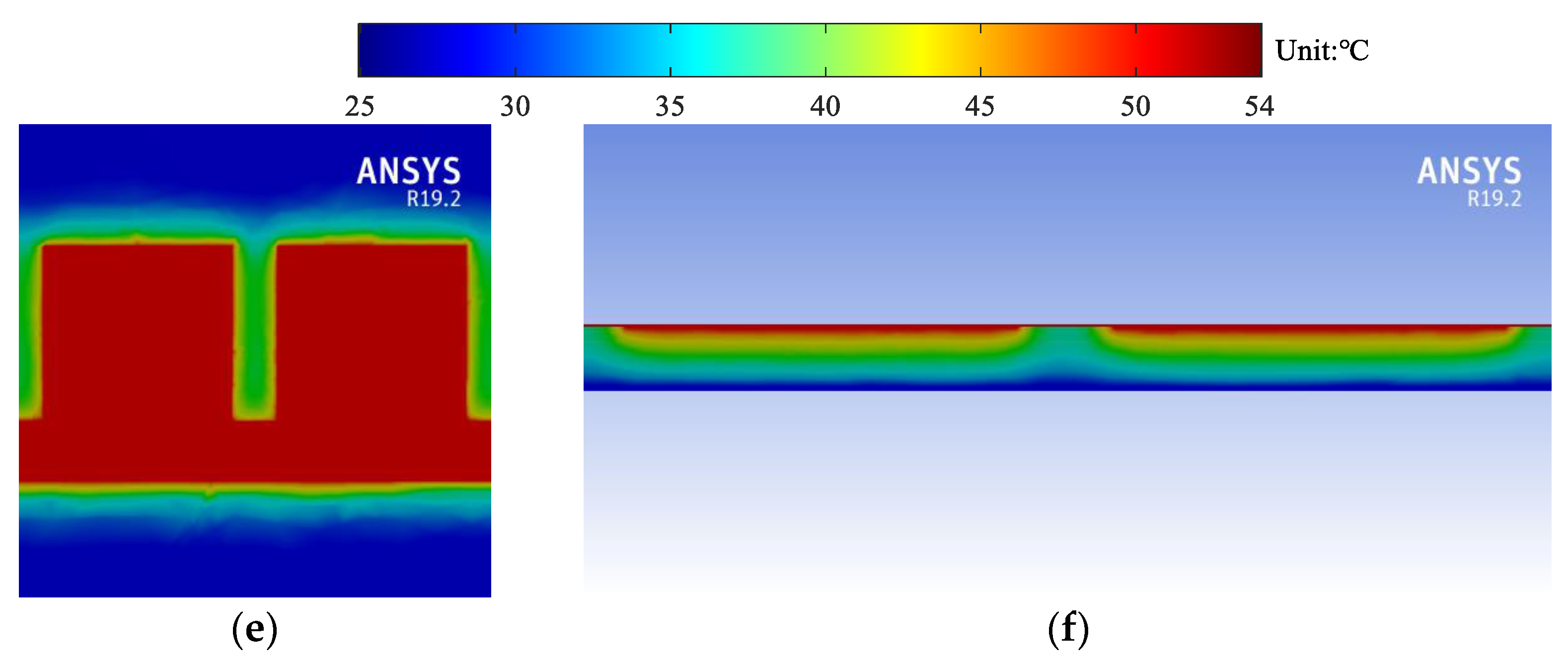
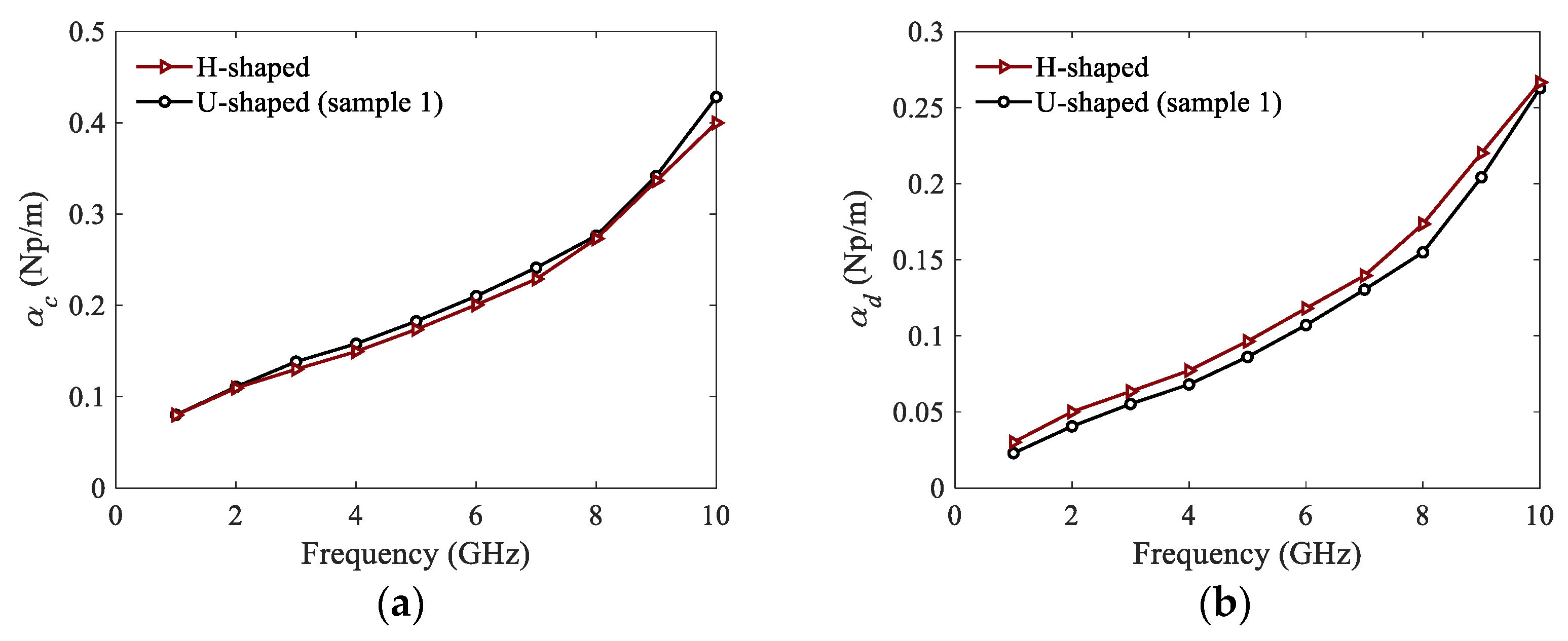
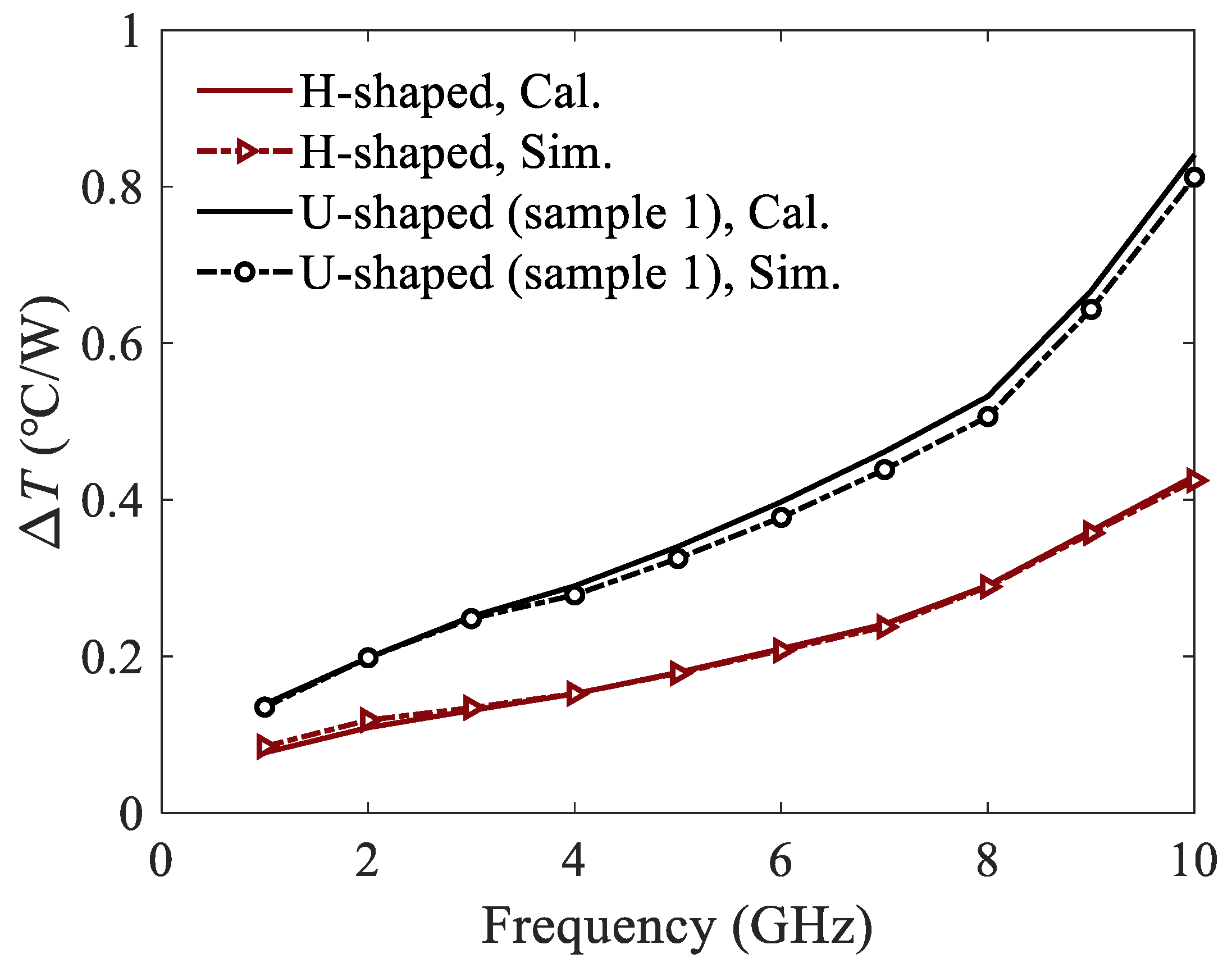
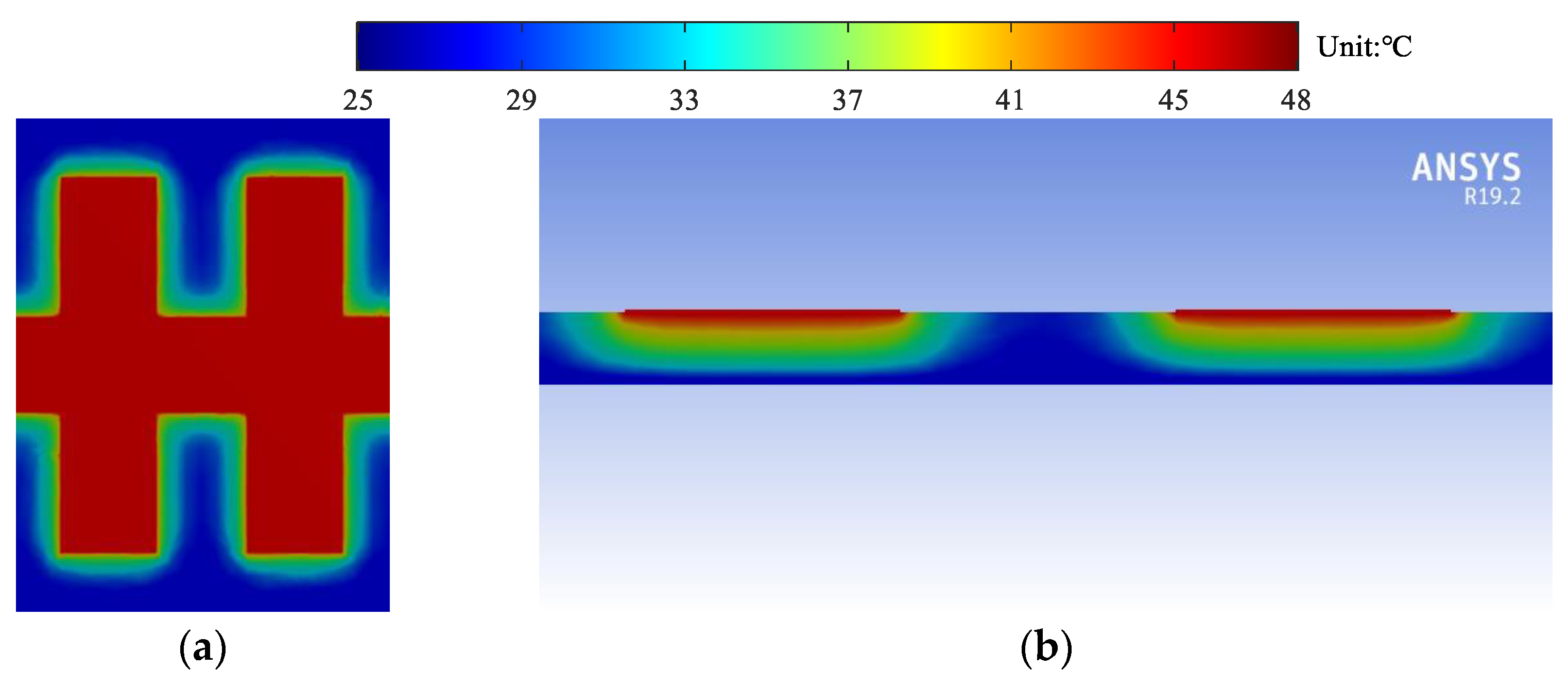
| a | h | p | w1 | |
|---|---|---|---|---|
| Sample 1 | 2 | 3 | 4 | 1 |
| Sample 2 | 2 | 1.5 | 4 | 1 |
| Sample 3 | 0.8 | 3 | 4 | 1 |
| Sample 1 | Sample 2 | Sample 3 | |
|---|---|---|---|
| Rthc | 0.7674 | 1.0670 | 0.6027 |
| Rthd | 0.3495 | 0.4816 | 0.2811 |
| a | h | p | w |
|---|---|---|---|
| 2 | 3 | 4 | 4 |
| H-Shaped | U-Shaped (Sample 1) | |
|---|---|---|
| Rthc | 0.4108 | 0.7674 |
| Rthd | 0.1914 | 0.3495 |
| ANSYS | Proposed Model | Proposed Model (TDR 1) | |||
|---|---|---|---|---|---|
| APHC (W) | APHC (W) | RE 2 | APHC (W) | RE | |
| U-shaped (sample 1) | 78.5 | 89.2 | 13.6% | 80.6 | 2.6% |
| U-shaped (sample 2) | 105.5 | 122.4 | 16.0% | 110.6 | 4.9% |
| U-shaped (sample 3) | 115.3 | 130.1 | 12.8% | 117.8 | 2.1% |
| H-shaped | 153.9 | 174.2 | 13.2% | 157.8 | 2.5% |
Publisher’s Note: MDPI stays neutral with regard to jurisdictional claims in published maps and institutional affiliations. |
© 2022 by the authors. Licensee MDPI, Basel, Switzerland. This article is an open access article distributed under the terms and conditions of the Creative Commons Attribution (CC BY) license (https://creativecommons.org/licenses/by/4.0/).
Share and Cite
Zheng, Z.; Tang, M.; Zhang, H.; Mao, J. Average Power Handling Capability of Corrugated Slow-Wave Transmission Lines. Micromachines 2022, 13, 961. https://doi.org/10.3390/mi13060961
Zheng Z, Tang M, Zhang H, Mao J. Average Power Handling Capability of Corrugated Slow-Wave Transmission Lines. Micromachines. 2022; 13(6):961. https://doi.org/10.3390/mi13060961
Chicago/Turabian StyleZheng, Zehao, Min Tang, Haochi Zhang, and Junfa Mao. 2022. "Average Power Handling Capability of Corrugated Slow-Wave Transmission Lines" Micromachines 13, no. 6: 961. https://doi.org/10.3390/mi13060961
APA StyleZheng, Z., Tang, M., Zhang, H., & Mao, J. (2022). Average Power Handling Capability of Corrugated Slow-Wave Transmission Lines. Micromachines, 13(6), 961. https://doi.org/10.3390/mi13060961






